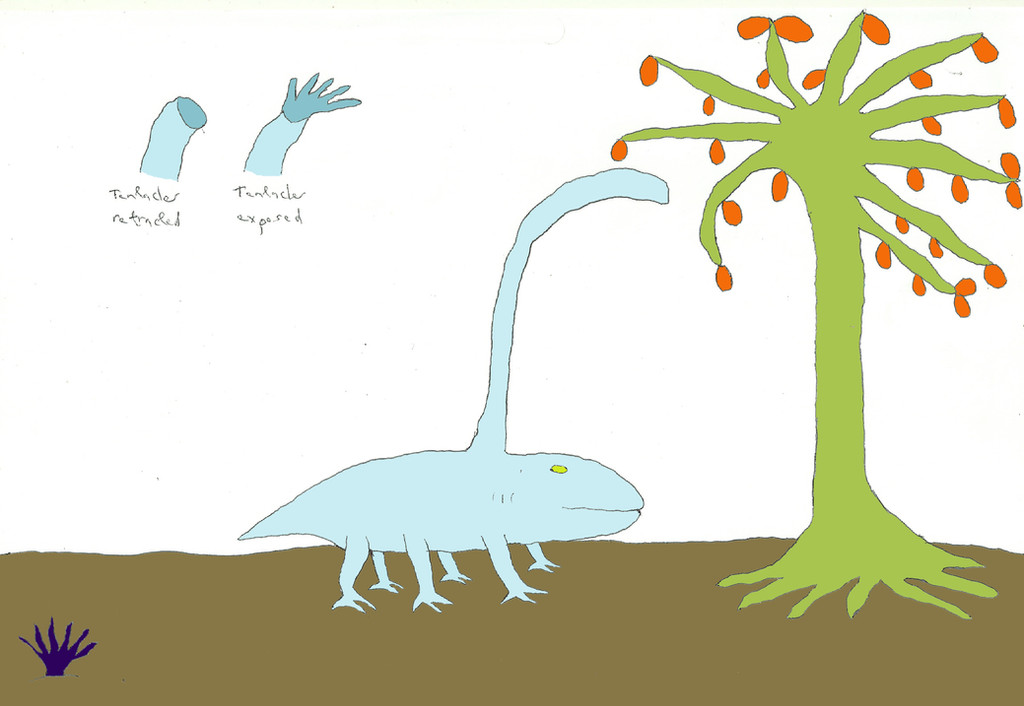HOME | DD
 Tarturus — Chekhov's Adaptation
Tarturus — Chekhov's Adaptation

#alien #creature #evolution #extraterrestrial #sciencefiction #scifi #tentacle #tree #tarturus #speculativeevolution
Published: 2017-02-16 06:01:11 +0000 UTC; Views: 1726; Favourites: 8; Downloads: 0
Redirect to original
Description
My entry for the Speculative Evolution forum contest COM#72: Chekhov's Adaptation: s1.zetaboards.com/Conceptual_E…Here is the description:
The Puzzling Appendage of the Tentacle Back
February 16, 2417
There are many weird and wonderful life forms found across the known worlds of the galaxy. Here I shall discuss just one example. The Tentacle Back, a creature found on the plains and open woodlands in the north-east regions of the continent of Misan, on the human colony world Kos. In many respects, the Tentacle Back is a rather unassuming member of the hexapedal "vertebrates" of Kos. But there is one particularly unusual feature of it. Namely, the feature that gives it its name- a long tentacular appendage growing from its back. This appendage can grow to as long as 2 metres- somewhat longer than the creature's 1.5 m body length- and contains a large number of bony rods that act as supports for the appendage but still give it a great deal of flexibility.
The purpose of the bizarre dorsal tentacle puzzled xenobiologists for some time. When the Tentacle Back was first officially described back in 2286 it was at first assumed that the tentacle was a sexual display feature. Yet both males and females had them and the structure was identical in both sexes. Due to the Tentacle Back's habitat being quite far from the nearest human settlements on Kos it took some time before this species was properly studied. As such it wasn't until 2291 that field studies in the wild confirmed what the real nature of their tentacle was. An appendage for obtaining food.
The Tentacle Back feeds on fruit-like objects (actually nutrient storage structures) growing on the small trees than inhabit its plains and woodlands habitats. These objects grow at a height of 1.5-3 metres above the ground. The Tentacle Back uses its tentacle to reach for the "fruits". A mass of smaller, retractable, tentacles will protrude from the big tentacles end and are used to grasp onto the "fruit" when plucking it.
The origins of the tentacle are still a matter of debate even to this day. It is known that the bony rods forming the tentacle's support are extensions of the spine. At least some other Kosian hexapeds are known to have spinal extensions forming simple display structures on their back that can be moved slightly, though no living species discovered so far have nearly as much freedom of movement as the incredible appendage of the Tentacle Back. There is one hypothesis that the precursor structure of the tentacle was originally for display purposes but was later adapted to the more practical use of food gathering. The problem with finding out how the tentacle came about is the lack of fossil evidence. Fossils of earlier cousins and possible ancestors of the Tentacle Back have revealed bygone creatures with a shorter dorsal tentacle useful for feeding from bushes and shrubs. But as for what preceded that, we shall just have to hope future fossil discoveries on Kos can solve this mystery.
In any case, the present day Tentacle Back has clearly grown dependent on its strange appendage, being a specialist on the high growing "fruit". This has been clearly seen in more than one case where a Tentacle Back was sighted with the tentacle missing, perhaps torn off by some predator. In such cases, the unfortunate Tentacle Back ends up starving to death. As unusual a feature as it is, it is a vital part of these creatures' survival.



























